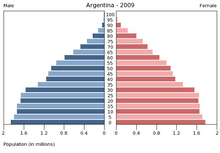Age stratification
In sociology, age stratification refers to the hierarchical ranking of people into age groups within a society.[1] Age stratification could also be defined as a system of inequalities linked to age. In Western societies, for example, both the old and the young are perceived and treated as relatively incompetent and excluded from much social life. Age stratification based on an ascribed status is a major source inequality, and thus may lead to ageism.[2] Ageism is a social inequality resulting from age stratification. This is a sociological concept that comes with studying aging population.[3] Age stratification within a population can have major implications, affecting things such as workforce trends, social norms, family structures, government policies, and even health outcomes.
| Age stratification exists because processes in society ensure that people of different ages differ in their access to society's rewards, power, and privileges. |
| —Age Stratification, Sociology: the essentials[1] |
Age structure

Age stratification is not a fixed phenomenon, but rather varies with the passage of time and between cultures and populations.[4] Shifting age structure of a population changes the age stratification. As life expectancy has increased dramatically in the last two centuries, the age strata by which people are characterized has changed. With people living longer lives than ever before in more developed areas of the world, there is now a category of "old-old" people which refers to persons ages 85+.[5] Changes in the age structure of populations affects the way in which they distribute resources, along with a shift in expectations from different age strata. For example, as Japan's population has dramatically aged - with individuals aged 65+ accounting for approximately 25% of the population - the country has found itself with an unfavorable dependency ratio.[6] In an effort to avoid economic downfall, the expectations of young-old and middle-old people have changed. Elderly citizens are encouraged to put off retirement, and the elderly tech market is booming.[6]
Age discrimination
Age is a major component of entry and exit for many parts of life – school, starting a family, retirement, etc.[7] Shifting social status with age can lead to ageism. Discrimination by a person's age can have profound impacts on the way a society operates – including behavioral expectations, the distribution of resources, and even policies and laws.
Workplace
In the United States, discrimination on the basis of one's age is prohibited in the workplace by the Age Discrimination in Employment Act of 1967. Enforced by the Equal Employment Opportunity Commission, the act is meant to keep employers unbiased in regards to age when dealing with hiring, promotions, terms, etc.[8] The law also makes it illegal for employees to be harassed due to their age.[9] Emergence of new occupations can lead to a polarization of age cohorts by workforce. As a result, a quick shift of the occupational distribution increases occupational age discrimination.[10]
Health outcomes
The unequal distribution of resources and social support between age strata can lead to health disparities in the population. In the U.S., evidence indicates older adults face higher risk of experiencing depression and other mental health issues.[7]
See also
References
- Andersen, Margaret L.; Taylor, Howard Francis (2006-02-22). Sociology: the essentials. Cengage Learning. pp. 87–88. ISBN 978-0-495-00683-1. Retrieved 28 January 2011.
- "age stratification - Dictionary definition of age stratification | Encyclopedia.com: FREE online dictionary". www.encyclopedia.com. Retrieved 2017-03-29.
- Scott & Marshall (2009). A Dictionary of Sociology. Oxford University Press. ISBN 9780191726842.
- Weeks, John (2014). Population An Introduction to Concepts and Issues. United States. pp. 298–340. ISBN 9781305094505.
- "Chapter 13. Aging and the Elderly – Introduction to Sociology – 1st Canadian Edition". opentextbc.ca. Retrieved 2018-03-29.
- Schlesinger & Martin (2016-01-16). "Graying Japan Tries to Embrace the Golden Years". Wall Street Journal.
- Clarke; et al. (June 2011). "The Social Structuring of Mental Health over the Adult Life Course: Advancing Theory in the Sociology of Aging". Social Forces. 89 (4): 1287–1313. doi:10.1093/sf/89.4.1287. JSTOR 41290130. PMC 3210581. PMID 22081728.
- "Age Discrimination". United States Department of Labor. 2015-12-09. Retrieved 2018-03-29.
- "Age Discrimination". EEOC. Retrieved 2018-04-05.
- MacLean, Alair (2006). "Age stratification at work: Trends in occupational age segregation in the United States, 1950–2000". Research in Social Stratification and Mobility. 24 (3): 299–310. doi:10.1016/j.rssm.2005.08.001.
Further reading
- Clauson, John (1971-08-30). "Age Stratification and the Individual" (PDF). US Department of Health Education and Welfare Office of Education. Retrieved 2008-01-16. Cite journal requires
|journal=(help) - Keel, Robert (2008-09-16). "Age Stratification". US Department of Health Education and Welfare Office of Education. Retrieved 2008-01-17.
- Maclean, Alair (2000-10-20). Age Stratification at Work: Continuity and Change in the American Occupational Structure, 1950-1990 (MS thesis). Department of Sociology Center for Demography of Health and Aging, University of Wisconsin–Madison. CiteSeerX 10.1.1.26.152. OCLC 50073658.